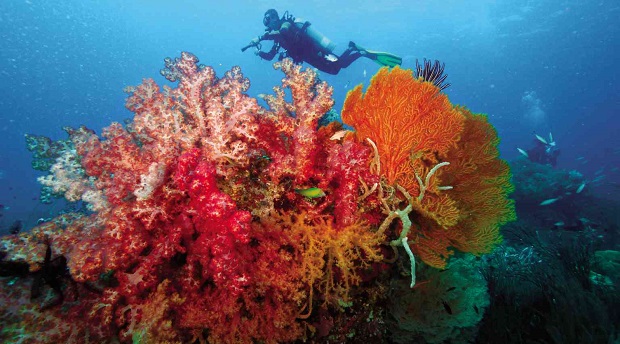
Scuba divers will never stop telling you: The Philippines is one of the best places in the world to dive. Just ask dedicated locals as well as visitors from all over the world, including award-winning underwater photographers and marine biologists, who come for stuff big and small.
While sightings of large animals and pelagics are getting more and more rare because of habitat destruction and human consumption, you can still count on memorable encounters, as well as an abundance of the colorful little critters that divers like to look out for.
Here are five prime dive destinations in the country:
Tubbataha, Sulu Sea
The pinnacle of Philippine diving in every way and considered the “Last Frontier” of our waters, the Tubbataha Reefs, 182 kilometers southwest of Puerto Princesa City in Palawan province, and the neighboring Jessie Beazley Reef make up the Tubbataha Reefs Natural Park.
It’s a Unesco World Heritage site, a hotbed of biodiversity that hit the headlines most recently when a US Navy ship ran aground there in January 2013. Our guess is that the Americans tried to get some diving done.
Tubbataha is only for experienced divers, though, as the currents can be treacherous. The rewards are great, however—sightings of white and black tip reef sharks, whale sharks, mantas, turtles and hammerheads.
Legendary sites like Shark Airport, Black Rock, Seafan Alley and Washing Machine are accessible only by live-aboard dive boats in the summer. Any other time, the waters of the Sulu Sea are too rough, and it’s an overnight trip from Puerto Princesa to the site for at least five days of diving in over 10,000 hectares of reefs that are home to half of the coral species on earth, some 500 species of fish, 11 kinds of sharks and more.
It will cost you, but every diver should visit at least once.
Getting there: Fly to Puerto Princesa and get on a live-aboard boat that must be booked in advance.
Anilao, Batangas
The new scuba diver’s first classroom in Anilao, Batangas province, is also one of the country’s most popular sites, only two hours by car from Manila.
With locals now taking care of the gold mine that is the dive tourism industry, reefs have managed to thrive. You can count on lots of fish, occasional sightings of turtles, sharks and barracuda, lovely soft coral and the tiny, colorful macrophotographers’ favorite subjects, such as shy pygmy seahorses and nudibranchs, which look like sea slugs in psychedelic colors.
There’s a wide range of resorts with good food and facilities, excellent roads and some of the most colorful diving this side of the archipelago.
Getting there: Get in a car and drive, and don’t forget to stop for bulalo or tawilis on the way!
Coron, Palawan
This one’s for the diver hankering for history and exploration, as Coron is home to several World War II wrecks, Japanese supply ships that were sunk by American forces in the battle of Coron Bay in September 1944. Vessels like the Akitsushima, Iraku and Olympia Maru are big, ghostly and fascinating to visit, but some degree of experience is required so you don’t kick up the sand and mess up the entire dive.
All wrecks are accessible by banca from Coron resorts in a wide range of budgets.
Make sure you dive the otherworldly Barracuda Lake, where you climb through Tagbanua ancestral areas (read: be respectful and don’t litter) before plunging into the warm water and meeting the resident barracuda.
Don’t miss the beautiful Gunter’s Cathedral, a chamber with a skylight carved in the rocky ceiling and water so clear, you’ll feel like you’re swimming in air.
Getting there: Fly to Coron and book at any of the good resorts and dive operators’ haunts, including the still-gorgeous Club Paradise.
Apo Reef, Mindoro
The Apo Reef Natural Park is a 27,469-hectare natural marine park between Mindoro and Palawan provinces, home to the world’s second largest continuous coral reef, and the largest atoll in the Philippines.
Apo Reef has been battered a bit by typhoons and climate change, but clear water, corals, colorful fish, turtles, schools of jacks, mammoth tuna and manta rays still entice the adventurous traveler.
The best way to get there is via live-aboard boats again, usually huge souped-up bancas comfortable enough to sleep in. The Park Rangers’ station, with its white sand beach and stunning views, is a good stopover.
Getting there: Fly to San Jose, Mindoro, and set up base at any resorts that offer diving in Apo Reef, such as the Apo Reef Club.
Apo Island, off Dumaguete
This is a successfully managed marine reserve that is the laboratory of nearby Silliman University, a center for marine biology education.
Apo Island (sometimes confused with the reef, which is between Mindoro and Palawan) boasts of speedy currents and dense fish life. There’s fun shallow diving, as well as trips into the depths in spots such as Mamsa Point Dauin and Coconut Point.
Downtime in the city is always something to look forward to.
Getting there: Fly to Dumaguete, stay in the city or book with any of the many experienced dive operators in the area.
Plus: One site where you don’t need scuba gear: Donsol, Sorsogon province, where you can swim with whale sharks in an environmentally sound, sustainable way (read: you don’t mess with nature by feeding the animals). Summer is the best time to encounter these gentle giants, but as always, be a responsible tourist and maintain a respectful distance from the animals.
RELATED STORIES
Sun, sea, and bubbles: Why these 6 sites are heaven
Scuba divers name PH, Malaysia best destinations in Pacific, Indian Oceans
Tubbataha still open to divers
Underwater biodiversity to bring in more tourists
Coron hot destination of the moment










































